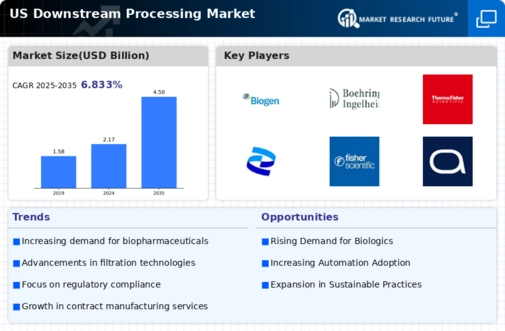The US Downstream Processing Market has seen significant growth, influenced by the increasing demand for biopharmaceutical products and the advancement in bioprocessing technologies. As the industry continues to evolve, competition within the market has intensified due to the presence of various key players focused on innovation, efficiency, and cost-reduction strategies.
The downstream processing segment encompasses techniques essential for the purification and production of biological drugs, such as filtration, chromatography, and other separation processes. Players in this market are striving to enhance their product offerings and expand their market reach through strategic partnerships, collaborations, and technological advancements to maintain a competitive edge.
The market dynamics are further shaped by the rising prevalence of chronic diseases, an aging population, and increased investment in research and development for biopharmaceutical interventions.
Danaher Corporation
Danaher Corporation has established a strong foothold in the US Downstream Processing Market through its comprehensive portfolio of life sciences and diagnostics offerings. The company is recognized for its commitment to technological innovation and has developed advanced solutions that enhance purification and filtration processes, catering to the specific needs of biopharmaceutical manufacturers.
Danaher’s strength lies in its robust R&D capabilities, enabling the company to consistently introduce cutting-edge products that improve operational efficiencies. With a focus on customer-centric solutions and deep industry expertise, Danaher Corporation has built strategic partnerships with leading pharmaceutical manufacturers and bioprocessing facilities across the US, further solidifying its position as a key player in the market.
Biogen
Biogen, a prominent biotechnology company, plays a significant role in the US Downstream Processing Market, particularly through its robust research and development initiatives that support the production of biologics. The company specializes in therapies for neurological diseases, which have required sophisticated downstream processing techniques to ensure the quality and efficacy of its products.
Biogen's strengths include a solid pipeline of innovative therapies and a focus on optimizing downstream processes to enhance production yield and efficiency. Over recent years, the company has made strategic acquisitions to augment its capabilities in bioprocessing, enabling it to leverage new technologies and streamline its operations. Biogen's presence in the US market is significantly bolstered by its commitment to healthcare advancements and its influence on shaping industry standards through continuous improvement and collaboration with other key stakeholders.



















